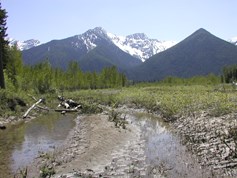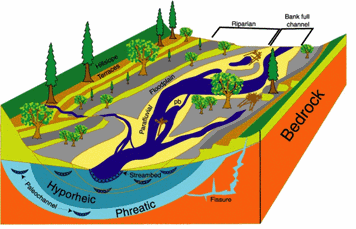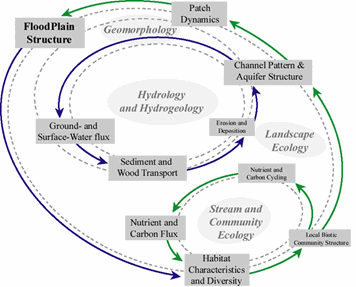Emergent Properties of Alluvial River Flood Plains
Principal Investigators:
Jack Stanford, F. Richard Hauer, John Kimball, Mark Lorang - FLBS and UM; Ray Callaway, UM Division of Biological Sciences; Steven Sheriff, William Woessner - UM Geology Department; Geoff Poole - University of Georgia; Daniel Fagre - US Geological Survey; William Swaney - Salish and Kootenai CollegeFunded by:
National Science Foundation, Washington, D.C. - Project number: EAR-0120523Details
The conceptual foundation of this multi-disciplinary project is that river flood plains are regional centers of ecological organization. This system is dependent on interactions among dynamic, nonlinear physical and biological processes linking water, heat and materials (biota, sediment, plant-growth nutrients) flux and retention to fluvial landscape change. Key processes driving biogeochemical patterns and cycles include flood-caused scour and sedimentation (cut and fill alluviation), routing of river water and nutrients above and below ground, channel movement (avulsion) and production and entrainment of large wood. Groundwater routing through the flood plain and upwelling back to the surface involves penetration of river water into zones of high hydraulic conductivity (subsurface paleochannels) within the bed sediments that are created by channel scour and subsequent filling with sorted gravel and cobbles. Strong interactions between short-duration, high stream-power floods, channel and sediment movement, increased roughness due to presence of vegetation and dead wood and upwelling of groundwater creates a complex, dynamic distribution of resource patches, which we refer to as the shifting habitat mosaic.
Using this conceptual foundation and implications of two decades of research on expansive gravel-cobble flood plains in western USA rivers, we are investigating a set of working hypotheses that address emergent properties of these and other similar flood plains. We use a complex hydrologic model to route water through the shifting habitat mosaic of our main study site, the Nyack Flood Plain Research Natural Area of the Flathead River, Montana. This model is novel because it is spatially explicit and 3-dimensional, linking surface and subsurface features and processes. Guided by our hypothesis-oriented field studies and experiments, we are improving and integrating this hydrologic model with new channel change, heat flux and nutrient cycling models in a dynamic flood plain biogeochemical simulator that is initialized from remote sensing information. The goal is spatially explicit quantification of heat and nutrient fluxes in relation to the habitat dynamics. This computational framework will be developed and validated at our Montana study site, and model results compared to other sites in the USA, Europe and the Russian Far East.

Idealized view of the 3-D structure of alluvial river ecosystems
This research portends to shift the science toward a nonlinear, more dynamic view that emphasizes energy dispersion and materials retention and cycling within large flood plains as the primary organizing elements of regional landscapes and ecosystems. Our education program cuts across cultural and professional boundaries and adds significant ecological literacy by providing hands-on demonstration of the importance of river flood plains in maintaining regional ecological organization.

Conceptual model of floodplain biocomplexity and system dynamics.
Emergent Properties of Flood Plain Rivers
- The porous floodplain bed sediments are laced with zones of preferential flow or paleochannels, which appear to be the cobble-boulder beds of previous river channels that have filled with upwardly-fining gravel after avulsion events.
- Subsurface paleochannels route river water at high velocities (up to 10 cm/s) from localized injection points (avulsion nodes) through the aquifer; spring brooks, ponds and other distinctive alluvial wetlands occur wherever saturated paleochannels intersect the surface.
- Abundant, large-bodied invertebrates are top consumers in species-rich food webs of the floodplain ground waters and are substantially more abundant in paleochannels than in the adjacent bed sediment matrix.
- The groundwater food web is driven by epilithic bacteria that metabolize dissolved organic matter from the riparian zone and the river; C, N and P transformations in the groundwater stimulate productivity bursts in upwelling zones.
- Entrainment of large wood is critical for the initiation of the floodplain riparian forest over the long-term.
- Browsing animals shape the ultimate characteristics of floodplain forests.
- Regional biodiversity of plant and animal assemblages maximizes on river flood plains because of diverse environmental conditions and resource gradients within the expansive 3-dimensional, shifting habitat mosaic.
Project Papers
- Harner, M. J. and J. A. Stanford. 2003. Difference in cottonwood growth between a losing and a gaining reach of an alluvial flood plain. Ecology (in press)
- Poole, G. C., J. A. Stanford, S. W. Running, C. A. Frissell and B. K. Ellis. 2003. Floodplain Hydrologic Complexity: Modeling Interactions between River Discharge, Geomorphology, and Hyporheic Flow Dynamics. Ecological Applications (submitted).
Pre-project Papers
- Craft, J. A., J. A. Stanford and M. Pusch. 2002. Microbial respiration within a floodplain aquifer of a large gravel-bed river. Freshwater Biology 47(2):251-261.
- Mouw, J. E. B. and P. B. Alaback. 2003. Putting floodplain hyperdiversity in a regional context: An assessment of terrestrial - floodplain connectivity in a montane environment. Journal of Biogeography in press.
- Mouw, J. E. B., J. A. Stanford and P. B. Alaback. 2003. Influences of FluvialProcesses and Hyporheic Exchange on Floodplain Plant Diversity and Productivity. Oikos (submitted)
- Pepin, D. M. and F. R. Hauer. 2002. Benthic responses to groundwater-surface water exchange in two alluvial rivers in northwestern Montana. Journal of North American Benthological Society 21(3):370-383.
- Poole, G. C., J. A. Stanford, C. A. Frissell and S. W. Running. 2002. Three-dimensional mapping of geomorphic controls on flood-plain hydrology and connectivity from aerial photos. Geomorphology 48(4):329-347.
- Whited, D. C., J. A. Stanford and J. S. Kimball. 2003. Application of airborne multispectral digital imagery to characterize the riverine habitat. Verh. Internat. Verein. Limnol. 28(3):1373-1380.

